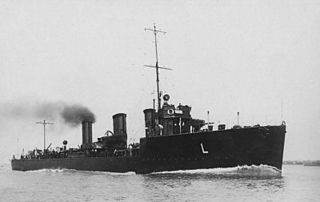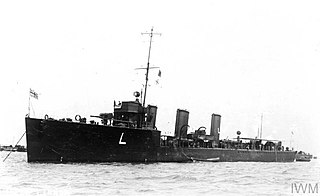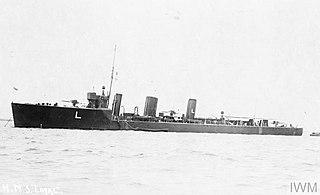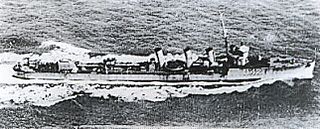Description
The Laforey class were improved and faster versions of the preceding Acasta class. [1] They displaced 965–1,010 long tons (980–1,026 t). The ships had an overall length of 268 feet 10 inches (81.9 m), a beam of 27 feet 8 inches (8.4 m) and a draught of 10 feet 6 inches (3.2 m). Lassoo was powered by two Parsons direct-drive steam turbines, each driving one propeller shaft, using steam provided by four Yarrow boilers. [2] The turbines developed a total of 24,500 shaft horsepower (18,300 kW) and gave a maximum speed of 29 knots (54 km/h; 33 mph). The ships carried a maximum of 280 long tons (280 t) of fuel oil that gave them a range of 1,750 nautical miles (3,240 km; 2,010 mi) at 15 knots (28 km/h; 17 mph). The ships' complement was 74 officers and ratings. [3]
The ships were armed with three single QF 4-inch (102 mm) Mark IV guns and two QF 1.5-pounder (37 mm) anti-aircraft guns. These latter guns were later replaced by a pair of QF 2-pounder (40 mm) "pom-pom" anti-aircraft guns. The ships were also fitted with two above-water twin mounts for 21-inch (533 mm) torpedoes. [3]

HMS Lydiard was a Laforey-class destroyer built for the Royal Navy during the 1910s.
HMS Ossory was an Admiralty M-class destroyer built for the Royal Navy during the First World War. She took part in the Battle of Jutland in 1916 and was sold for scrap in 1921.
HMS Nomad was an Admiralty M-class destroyer built for the Royal Navy during the First World War. She was sunk during the Battle of Jutland in 1916.
HMS Phoebe was an Admiralty M-class destroyer built for the Royal Navy during the First World War. She took part in the Zeebrugge Raid in 1918 and was sold for scrap in 1921.

HMS Laertes was a Laforey-class destroyer built for the Royal Navy during the 1910s.
HMS Turbulent was an S-class destroyer built for the Royal Navy during the First World War.
HMS Ophelia was an Admiralty M-class destroyer built for the Royal Navy during the First World War, entering service in 1916. The ship served at the Battle of Jutland on 31 May/1 June 1916, and sank a German submarine in 1918. She was sold for scrap in 1921.

HMS Legion was a Laforey-class destroyer built for the Royal Navy during the 1910s.

HMS Lennox was a Laforey-class destroyer built for the Royal Navy during the 1910s.

HMS Loyal was a Laforey-class destroyer built for the Royal Navy during the 1910s.
HMS Onslow was an Admiralty M-class destroyer built for the Royal Navy during the First World War. She took part in the Battle of Jutland in 1916 and was sold for scrap in 1921.

HMS Louis was a Laforey-class destroyer built for the British Royal Navy during the 1910s. She participated in the Dardanelles campaign, during which she was wrecked in Suvla Bay in 1915.

HMS Pasley was an Admiralty M-class destroyer built on the Tyne by Swan Hunter & Wigham Richardson for the Royal Navy and launched on 15 April 1916. She saw service during the First World War.
HMS Narborough was an Admiralty M-class destroyer built for the Royal Navy during the First World War. She was wrecked after running aground in 1918.

HMS Scythe was an S-class destroyer built for the Royal Navy during the First World War. She was involved in the Irish Civil War in the interwar period before being sold for scrap in 1931.

HMS Partridge was a Royal Navy Admiralty M-class destroyer constructed and then operational in the First World War, later being sunk by enemy action in 1917. The destroyer was the sixth Royal Navy vessel to carry the name HMS Partridge.
HMS Pheasant was one of 85 Admiralty M-class destroyers built during the First World War for the Royal Navy. She hit and was sunk by a mine in 1917.
HMS Recruit was an R-class destroyer built for the Royal Navy during the First World War. She was sunk by a German U-boat four months after she was commissioned in April 1917.

HMS Somme was an Admiralty S-class destroyer built for the Royal Navy during World War I. Commissioned seven days before the end of the war, the ship was sold for scrap in 1932.

HMS Sarpedon was an R-class destroyer which served with the Royal Navy. The R class were a development of the preceding M-class, but differed in having geared turbines and other design changes. Launched in June 1916, the vessel escorted convoys that sailed between Scotland and Scandinavia in the First World War. After the war, the ship was allocated to local defence at Nore. However, in 1923, the Navy decided to retire many of the older vessels and Sarpedon was retired and was sold to be broken up on 23 June 1926.
This page is based on this
Wikipedia article Text is available under the
CC BY-SA 4.0 license; additional terms may apply.
Images, videos and audio are available under their respective licenses.










